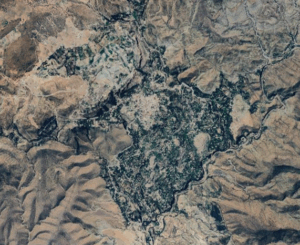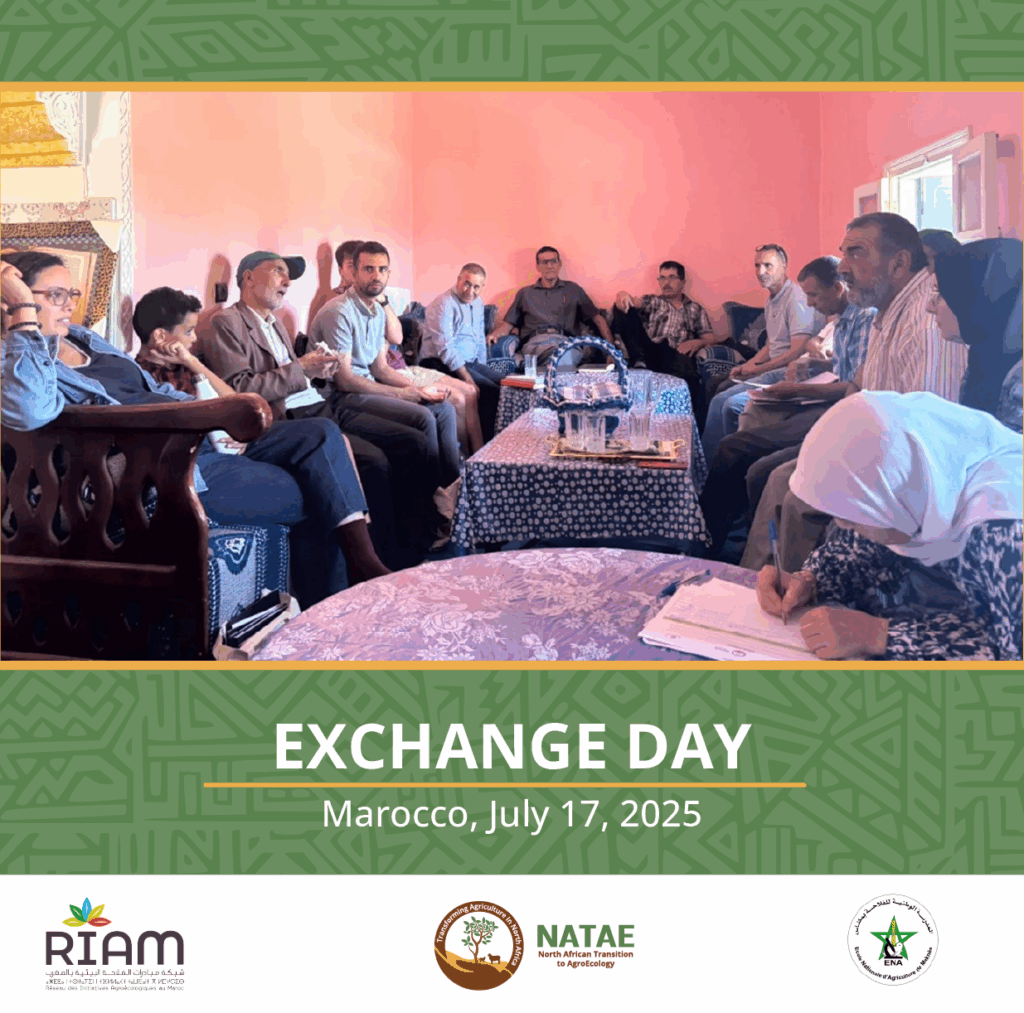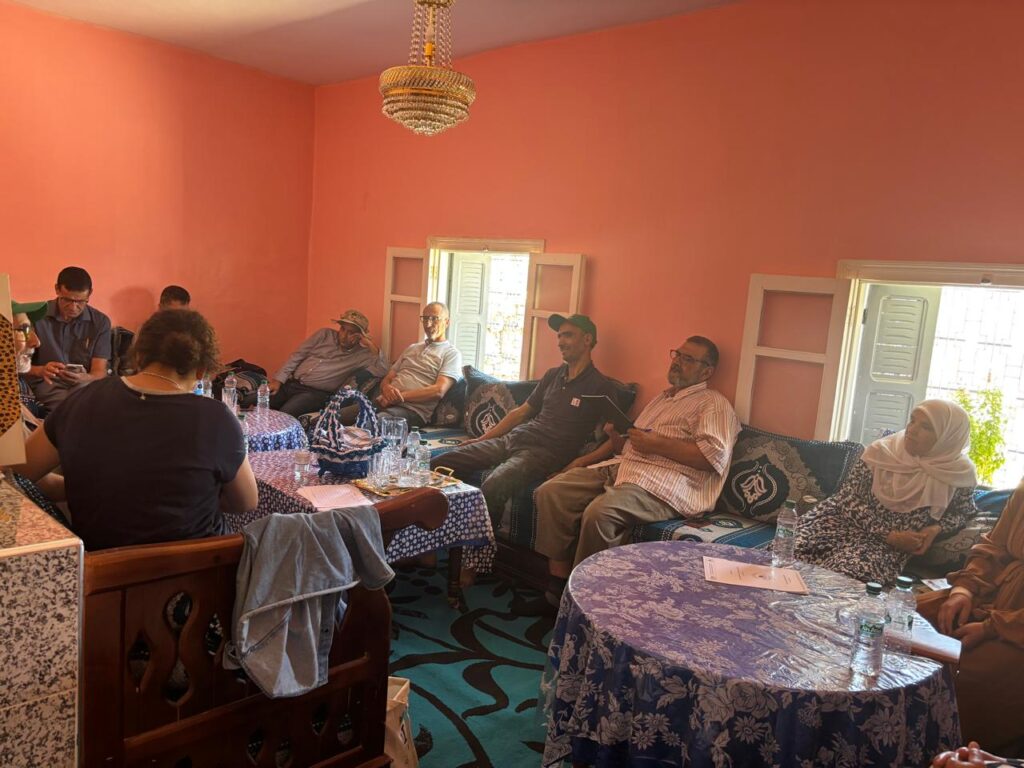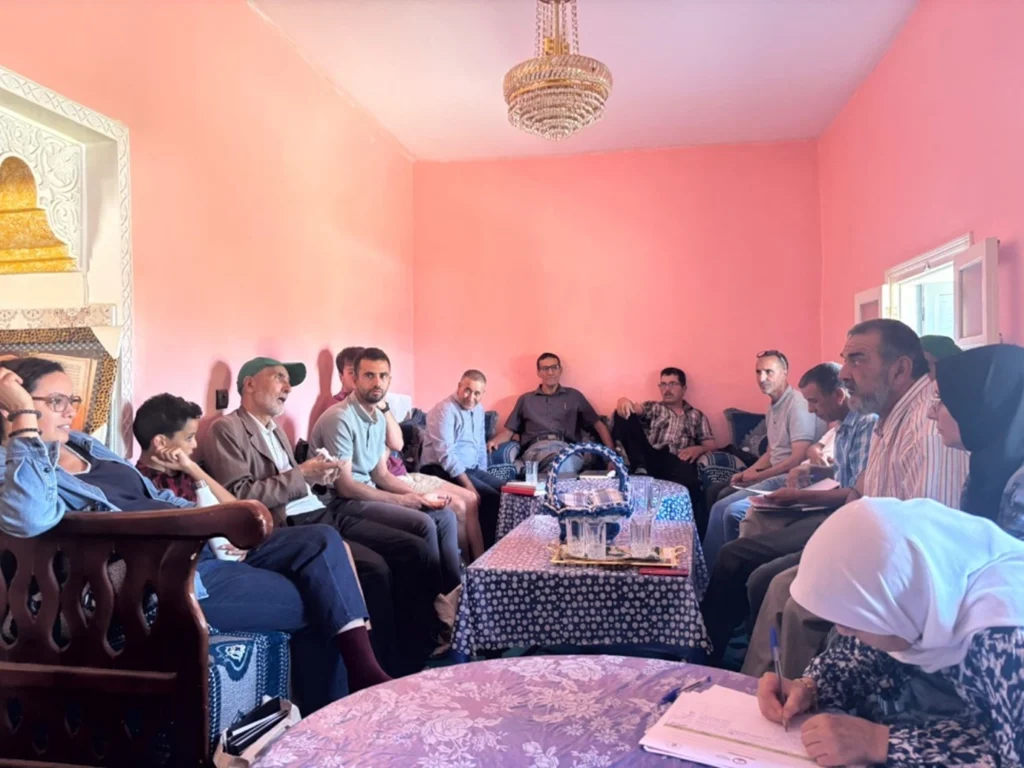Journée d'échange Laboratoire vivant de Skoura
Maroc, le 17 juillet 2025
1) Contexte et objectif :
Dans le cadre du projet NATAE, l'Ecole Nationale d'Agriculture de Meknès en collaboration avec le Réseau des Initiatives Agroécologiques au Maroc a organisé, le 17 juillet 2025, une journée d'échange entre les agriculteurs du Living Lab de Skoura sur le thème de l'agroécologie. Cette initiative est une approche participative visant à renforcer les connaissances des agriculteurs et à promouvoir l'apprentissage collectif des pratiques agroécologiques. L'objectif principal de la réunion était de fournir un espace aux agriculteurs pour partager leurs expériences et leurs connaissances locales, tout en abordant les défis rencontrés sur le terrain. Ces échanges ont permis aux participants de réfléchir collectivement à des alternatives aux pratiques agricoles conventionnelles par rapport aux réalités agro-climatiques du territoire de Skoura. Cette activité a également contribué à créer une dynamique communautaire au sein du Living Lab et à soutenir la transition agroécologique engagée sur le territoire.
2. le lieu de l'activité :
L'activité s'est déroulée au Living Lab montagneux de Skoura M'daz, situé dans la préfecture de Boulemane, dans la région de Fès-Meknès. La sélection des participants a été faite de manière à assurer une représentation des différentes zones du Living Lab, en tenant compte de la diversité des conditions locales en matière de disponibilité et de gestion de l'eau et des systèmes agricoles. Des représentants d'associations et de coopératives actives sur le territoire ont également été invités afin d'assurer une large diffusion des informations et des échanges issus de cette journée à l'ensemble de la communauté du Living Lab.

3) Procédure d'échange
La session a débuté par une présentation des participants, composés de 16 agriculteurs issus des différentes zones du Living Lab de Skoura M'daz, représentant diverses coopératives (notamment dans les secteurs des plantes aromatiques et médicinales, des olives, etc. Les équipes de l'ENAM et du RIAM étaient également présentes.
L'échange a été initié par un membre de l'équipe du RIAM, qui a souligné l'importance de l'agroécologie comme seule alternative viable pour préserver un système agricole sain, respectueux de la nature et bénéfique pour la santé humaine. En particulier, il a été mentionné que les problèmes croissants de fertilité et de qualité des sols, ainsi que la raréfaction des ressources en eau, rendent cette transition indispensable.
Le président du RIAM a ensuite introduit la discussion autour du concept d'agroécologie, invitant les agriculteurs à partager leurs propres définitions et perceptions. Cette ouverture a permis aux participants d'échanger librement et de souligner les avantages qu'ils associent à l'agroécologie, en particulier l'abandon des pesticides et des produits chimiques, perçu comme un pas vers une agriculture plus saine.
La discussion s'est ensuite orientée vers un ensemble de pratiques agricoles et agroécologiques, notamment :
- La fertilisation organique (compost, fumier, thé de fumier), reconnue pour son rôle dans la conservation de la biodiversité, tant en surface qu'en sous-sol. Un participant a soulevé la différence entre le fumier, riche en azote et en carbone, et le thé de fumier, qui ne contient que de l'azote, nécessitant ainsi un apport externe de carbone.
- Le labourage profond, critiqué pour ses effets négatifs sur la biodiversité interne du sol, perturbe les écosystèmes, réduit l'humidité du sol et contribue à la dégradation du sol. Il perturbe les écosystèmes, réduit l'humidité du sol et contribue à sa dégradation.
- L'association des légumineuses avec d'autres cultures, soulignée pour sa capacité à enrichir le sol en azote grâce à la bactérie Rhizobium, présente dans les racines des légumineuses.
- La rotation des cultures, recommandée pour ses avantages économiques (diversification des revenus) et écologiques (amélioration de la fertilité des sols et de la biodiversité).
- L'utilisation de semences locales, plus adaptées aux conditions climatiques et aux sols du territoire.
- La gestion de l'eau et l'irrigation, un sujet largement débattu. Il a été souligné que dans certains contextes, l'irrigation par gravité peut être plus bénéfique que l'irrigation au goutte-à-goutte, surtout si elle est effectuée toutes les deux semaines. Cette méthode favorise un développement plus profond des racines. Les participants ont également insisté sur l'importance de la présence humaine sur la parcelle et du lien émotionnel avec les cultures. Le moment optimal pour l'irrigation a été identifié entre minuit et 3 heures du matin, lorsque les plantes absorbent le mieux l'eau.
L'agroforesterie, perçue comme un levier essentiel pour la protection de l'écosystème, grâce à l'association harmonieuse entre les arbres et les cultures agricoles.
Enfin, la question de savoir comment convaincre les agriculteurs de s'engager dans une transition agroécologique a été soulevée par l'un des participants. Il a été répondu que les avantages concrets de l'agroécologie - tels que la réduction des intrants, la diminution des coûts de production et la diversification des revenus - constituent des arguments convaincants et prometteurs pour encourager l'adoption progressive de ces pratiques durables.
La discussion a également porté sur le système participatif de garantie - RIAM. Les participants ont discuté du fonctionnement du système de garantie participatif, de ses exigences, de ses avantages pour les petits producteurs, ainsi que de la procédure à suivre pour obtenir cette certification.


